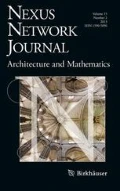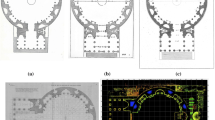Abstract
We analyze in detail a specific image of curvilinear perspective developed by Andre Barre and Albert Flocon in 1968 which depicts a square room from its interior by a 360° total perspective. Since its publication, their work has become an important point of reference, but they did not say how it was done. We discuss how this specific case of a pseudo-spherical projection for a hypercube was achieved by hybridized using ellipse curves in one of the spatial directions and a different spherical projection in the other direction. For this analysis we develop the mathematical expressions and study how the ellipsoidal and spherical transformations are hybridized into one solution. Barre and Flocon attempted to use both projections in an angular curvilinear grid as a practical drawing method. One of the main interests of having access to a 360° curvilinear grid arises its ability to act as a drawing guide. We provide an example of its use to demonstrate its practicality.














Similar content being viewed by others
References
Araujo, Antonio. 2017. Guidelines for drawing Immersive Panoramas in Equirectangular Perspective. ARTECH2017: Proceedings of the 8th International Conference on Digital Arts, pp. 93–99. https://doi.org/https://doi.org/10.1145/3106548.3106606.
Araujo, Antonio. 2018. Ruler, Compass and Nail: Constructing a Total Spherical Perspective. Journal of Mathematics and the Arts 12(2-3): 144-169. https://doi.org/https://doi.org/10.1080/17513472.2018.1469378.
Araujo, Antonio. 2019. Eq A Sketch 360, a serious Toy for Drawing Equirectangular Spherical Perspectives. ARTECH 2019: Proceedings of the 9th International Conference on Digital and Interactive Arts, pp. 1–8. https://doi.org/https://doi.org/10.1145/3359852.3359893.
Bantjes, Rod. 2014. Hybrid Projection, Machinic Exhibition and the Eighteenth-Century Critique of Vision. Art History 37(5): 912-939. https://doi.org/https://doi.org/10.1111/1467-8365.12099.
Barre, Andre and Albert Flocon. 1968. La perspective curviligne de l’espace visuel à l’image construite. Paris: Flammarion.
Barre, Andre and Albert Flocon. 1985. La perspectiva curvilínea: del espacio visual a la imagen construida. Barcelona: Paidos Ibérica.
Barre, Andre, Albert Flocon and Georges Bouligand. 1964. Étude comparée de différentes méthodes de perspective, une perspective curviligne. Bulletin de la Classe des Sciences de La Académie Royale de Belgique, Série 5, Tome L.
Bourke, Paul. 2001. Computer generated Angular Fisheye Projections. http://paulbourke.net/dome/fisheye/ (last accessed: 7/12/2020).
Casas, Fernando R. 1983. Flat-Sphere Perspective. Leonardo 16(1): 1-9.
Casas, Fernando R. 1984. Polar Perspective: A Graphical System for Creating Two Dimensional Images Representing a World of Four Dimensions. Leonardo 17(3): 188-194.
Cousinery, Barthélémy Édouard. 1828. Géométrie Perspective, ou Principes de Projection Polaire Appliqués à la Description Des Corps. Paris: Chez Carilian-Goeury.
Elkins, James. 1988a. Did Leonardo Develop a Theory of Curvilinear Perspective? Journal of the Warburg and Courtauld Institutes 51: 190-196.
Elkins, James. 1988b. Das Nusslein beisset auff, ihr Künstler! Curvilinear perspective in seventeenth century dutch art. Oud Holland Jaargang 102-1998(4): 257-276.
Ernst, Bruno. 1976. The Magic Mirror of M.C. Escher. Ballantine Books.
Escher, Mauritz C. 1959. Grafiek en tekeningen. Netherlands: Koninklijke Uitgeverij J.J. Tijl.
Flocon, Albert and René Taton. 1966. La perspective, 7th ed. Paris: que sais-je?
García-Salgado, Tomás. 2015. Exploring Architectural Form in perspective: A Fractal Hyper-cube Building. In: Kim Williams, Michael J. Ostwald M. (eds.), Architecture and Mathematics from Antiquity to the Future, Vol. II, 513–524. Cham: Birkhäuser. https://doi.org/https://doi.org/10.1007/978-3-319-00143-2_35.
Gombrich, Ernst. 1961. Art and Illusion: A Study in the Psychology of Pictorial Representation, 2d ed. Princeton: Princeton University Press.
Greene, Ned. 1986. Applications of world projections. Proceedings of the 1986 conference on graphics interface 1986, 108–114. https://graphicsinterface.org/wp-content/uploads/gi1986-20.pdf (last accessed: 22/02/2021).
Hansen, Robert. 1973. This Curving World: Hyperbolic Linear Perspective. The Journal of Aesthetics and Art Criticism 32(2): 137-161.
Herdman, William Gawin. 1853. A Treatise On The Curvilinear Perspective Of Nature And Its Applicability To Art. London: John Weale and Co.
Inakage, Masa. 1991. Non-linear perspective projections. Modeling in Computer Graphics 1991: 203-215.
Kulcke, Matthias. 2019. Spherical Perspective in Design Education. FME Transactions 47(2):343-348. DOI: https://doi.org/10.5937/fmet1902343K.
Marrazzo, Massimo. 2018. How to draw curvilinear perspective 4–5–6 vanishing points. CreateSpace Independent Publishing Platform.
Panofsky, Erwin. 1991. Perspective as Symbolic Form. New York: Zone Books.
Schickard, Wilhelm. 1624. Weiterer Bericht Von der Fliegenden Liecht-Kugel, welche den 7. Novembris, Jüngsthin, am hellen Himmel erschienen: Sampt einem Kupfferblat. Staatliche Bibliothek Regensburg ‒ 999/Philos.1199.
Snyder, John and Philip Voxland. 1994. An Album of Map Projections. U.S. Geological Survey; Professional paper # 1453. Department of the Interior, U.S. Gov. Printing Office.
Snyder John. 1982. Map Projections Used by the U.S. Geological Survey. Geological Survey Bulletin 1532, 2nd ed. USGS Report. U.S. Gov. Printing Office, Wa., USA.
Tyler, Christopher. 2015. The Vault of Perception: Are Straight lines Seen as Curved?Art and Perception 3(1): 113-137. https://doi.org/https://doi.org/10.1163/22134913-00002028
Urbin, Agnes and Brigitta Szilágyi. 2015. Perspective with Six Vanishing Points: An Alternative Method. Periodica Polytechnica Civil Engineering 59(4): 591–601. https://doi.org/https://doi.org/10.3311/PPci.8433
Veltman, Kim H. 2004. Literature on perspective. Sources and literature of perspective, vol. III. Virtual Maastricht McLuhan Institute.
Acknowledgements
We wish to thank two anonymous reviewers and Editor-in-Chief Kim Williams for their valuable comments that greatly helped to improve the manuscript. All images are by the authors.
Author information
Authors and Affiliations
Corresponding author
Additional information
Publisher's Note
Springer Nature remains neutral with regard to jurisdictional claims in published maps and institutional affiliations.
About this article
Cite this article
Santoyo, J., Santoyo, M.A. The 360° Curvilinear Perspective: A Hybrid Hypercubic Angular Space Grid Based on the 1968 Barre and Flocon proposal. Nexus Netw J 23, 717–735 (2021). https://doi.org/10.1007/s00004-021-00552-1
Accepted:
Published:
Issue Date:
DOI: https://doi.org/10.1007/s00004-021-00552-1




